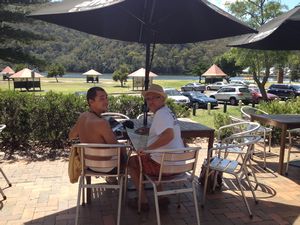Advertisement
Published: January 11th 2012

 Bobbin Head
Bobbin Head
Quick coffee to startJust a few kilometres away from us is Ku-Ring-Gai Chase National Park, a beautiful area that includes mangroves, bushland and rainforest and runs inland and up the coast so has some amazing headlands and lookout posts. We first saw areas of it from a nearby headland when we arrived and remember it looking very remote and wild, but it has slowly become more familiar landscape and an area I am really looking forward to getting to know more as so nearby.
I really felt we should do a day in the National Park before Josh left and so on Saturday Josh, Julian and myself got out early with the intention of having a full day there.
$11 for a day pass gives really good value and helps supports the habitat. With a vast number of trails and wanting to get the most out of the day, we decided our first port of call should be the visitors centre at Bobbin Head. Whenever you go anywhere here, the staff are generally really helpful and eager to share their knowledge with you. Most of the staff in the NP visitor centres are volunteers and soon sorted us out with a good
plan. After a quick coffee stop (becoming a bit of a habit) and suitably attired in sturdy walking boots we drove to the nearby Gibberagong Track (I love the names) which followed the course of Cockle Creek. Very soon we were walking along a boardwalk through mangroves, the mudflats alive with hundreds of little crabs constantly shovelling food into their mouths in the mudflats. As soon as they heard you they would scurry into their holes before quickly re-emerging. We heard the ones with bright emerald backs were the most likely to give a nasty nip. We were soon in what felt like proper bushland, following very narrow paths. We saw a brush turkey (which we get in our garden sometimes) fussing around a huge mound of leaves (around 3 mtrs diameter and 1.5 mtrs high) They build these from leaves and soil to lay their eggs deep inside which then heat up like compost heaps, incubating the eggs. We then spotted 2 chunky lizards (about half a metre long) snuggled up to each other. As we climbed the path we soon had fantastic views across that area of the park. Extensive damage caused by huge bush fires there in
the 1990’s and more recently was very evident, but the speed of regeneration was also extraordinary with strong regrowth sprouting from the charred remains. The plants are very different to what we see at home. I love the variety of patterns in the trunks of the gum trees here. My favourite at the moment is the Scribbly Gum which naturally shed their bark leaving beautiful surfaces and patterns but also revealing trails from insects boring under the bark, like natural graffiti.
Thankfully, no snakes seen on this trip and nothing really scary today.
We then moved on to the Kalkari Discovery Centre learning more about the local wildlife and had a personal talk from the very keen warden about the aboriginal site we were going to next and what to look out for.
We left that area of the park re-entering it further up to West Head for breathtaking views across Pittwater. Here we stopped off at Aboriginal sites one of which “Elvina’ we would have missed if we hadn’t been from talking to the warden earlier. This to me was the best one. It is apparently a ‘female’ site and was a good example of Aboriginal

 Tree Climbing
Tree Climbing
Before hearing that spiders live under the dead bark!!!rock carvings and very special.
After a full and fantastic day in this beautiful area, we then headed off to Balmoral for fish & chips (a bit of a shock after a day in the national park as very up market and materialistic) then just home in time to Skype Sam on his birthday.
SOBERING FACT:
The Ku-Ring-Gai area was home to the Guringai Aboriginal people. The British First Fleet arrived in Sydney and Governor Phillip commented on the friendliness of these people when he explored this area in August 1788. By April 1789 it was realised that many were dying from smallpox for which they had no natural resistance caught from the whites and by 1790, over half the Guringai nation had been wiped out. By the 1840’s, hardly any Aboriginal people remained in this area and their traditional lands were taken over by white settlers.
Advertisement
Tot: 0.08s; Tpl: 0.011s; cc: 7; qc: 44; dbt: 0.0406s; 1; m:domysql w:travelblog (10.17.0.13); sld: 1;
; mem: 1.3mb

 Bobbin Head
Bobbin Head 
 Tree Climbing
Tree Climbing
Nigel & Julie
non-member comment
on safari
Hi guys, What an adventure, sounds like you did well to get back out again! Reminds us of when we were in Oz two years back, we had a similar trip (without your mishaps) in Kakadu - Crocodile Dundee country. We were in a Toyota landcruiser & sometimes the terrain was a little scary to say the least, though the vehicle was brilliant. Like you, we saw some amazing wildlife, even Jake & Freya were impressed. Just coming out of a cold spell here in Devon, though we have avoided the arctic conditions of further north. Just heading off for a Dartmoor walk, in training for the Two Moors Way in May - a 120 miler from Wembury to Lynmouth. Julie is in serious training for the Isles of Scilly Gig championships around the same time. Otherwise all OK back here - looking forward to the Spring. All the best N&J